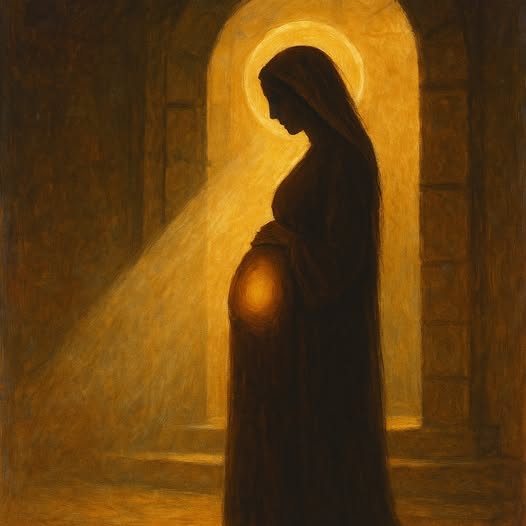
The story of the Flood in Genesis has long captivated interpreters, theologians, and skeptics alike. Its dramatic imagery of water bursting from below and pouring from above invites speculation about what the earth was like before the rains began. Some claim there was no rain at all prior to the Flood. Others propose that a vapor canopy or a sphere of water hovered above the atmosphere, shielding the earth until God released it in judgment. Still others imagine a world watered only from subterranean fountains, with the sky playing no role at all. These theories range from creative to speculative, but they often tell us more about modern concerns than ancient truth.
To recover what Scripture actually says about pre-Flood water, we must resist the urge to read the text through a scientific lens. The Bible speaks with theological precision, not with meteorological detail. When we allow Genesis to speak on its own terms, the picture becomes clearer. It is not simpler, but it is far more meaningful.
The Garden Is Not the Globe
One of the most commonly cited verses in support of a rainless pre-Flood world comes from Genesis 2. The text notes that before God planted the garden, no shrub or cultivated plant had yet appeared because there was no man to till the soil and no rain had fallen. Instead, a mist or spring rose from the ground to water the face of the land. At first glance, this might seem to suggest a planet-wide condition. But that is not the scope of the passage.
Genesis 2 shifts the focus from the universal creation of Genesis 1 to a particular land, later revealed to be Eden. The absence of rain is tied to the absence of cultivation, not to a global climate description. The mist or spring mentioned is not portrayed as a universal mechanism but as a local condition preparing the ground for God’s next act, forming Adam and planting the garden.
To take this verse as proof that no rain fell anywhere on earth until the Flood is to go beyond what the text actually states. It confuses a localized, narrative-specific observation with a universal claim about the entire antediluvian world. The point of the passage is to explain why Eden needed human stewardship, not to teach meteorology.
The Waters Above and the Canopy Theory
A second source of confusion comes from Genesis 1, where God separates the waters below from the waters above by means of an expanse. This expanse, often translated as “firmament,” was understood by ancient peoples as a solid dome that held back a heavenly ocean. Many cultures believed the sky itself was a barrier separating the ordered world from the chaos above.
Some modern interpreters, particularly in the twentieth century, tried to read this as a literal shell of water or vapor suspended above the atmosphere. This idea, often called the canopy theory, proposed that a watery sphere once surrounded the planet and collapsed at the time of the Flood, unleashing global rainfall for the first time.
But the text never describes such a structure. It does not say the “waters above” were a spherical layer clinging to the planet. The imagery comes from ancient cosmology, not modern climate science. The waters above are part of the symbolic structure along with the waters below. It is a poetic expression of God’s act of imposing order on primordial chaos.
The goal of Genesis is not to describe atmospheric layers. It is to declare that the God of Israel is the one who established boundaries between chaos and creation. Those boundaries were never guaranteed to hold forever. They depended on God’s ongoing faithfulness and the obedience of His image bearers.
Rain Before the Flood: A Question of Silence
Some believe that rain itself did not exist before the Flood, citing Genesis 7:4 where God announces that He will cause it to rain for forty days and nights. This, they argue, marks the first appearance of rain in the biblical narrative and implies it was unprecedented.
But this argument is built on silence. The verse does not say this is the first rain, only that this particular rainfall would be long and devastating. It is entirely possible, and perhaps likely, that rain was a normal part of life in the pre-Flood world but simply not mentioned until it became relevant to the narrative.
The writers of Genesis often omit mundane details that do not serve the theological message. The absence of a description does not mean an absence of existence. Genesis is not a catalog of natural processes. It is a carefully crafted account with a specific purpose, to show how God creates, blesses, judges, and restores.
When rain appears in the Flood story, it is not as a new invention but as part of the broader unmaking of the world. God is not simply sending a downpour. He is removing the boundaries He once set in place. The skies and the deep collaborate to return the world to a state of chaos. That is the point.
The Deep Breaks Loose
Genesis 7:11 tells us that on the day the Flood began, the fountains of the great deep burst forth and the windows of the heavens were opened. These are not merely geological or meteorological events. They are theological markers. The “deep,” or tehom, is the same term used in Genesis 1:2 to describe the dark, chaotic waters that existed before God’s creative ordering.
It is important to understand that tehom is not an independent or eternal force. Unlike the watery chaos gods of other ancient mythologies, the deep in Genesis is part of the created order. Yahweh made it. He ruled over it. There is no dualism in the biblical account. There is no rival deity or co-eternal substance standing against God. The waters were chaotic, but they were not uncreated. From the beginning, they were subject to Yahweh’s word.
To say the deep burst open is to say that the foundations of creation were undone. The boundaries that had held chaos at bay were shattered. This is not simply water coming up from underground springs. It is the re-emergence of what had been tamed, the uncreation of the world.
The Flood is not just a massive storm. It is a cosmic reversal. The heavens no longer hold back the waters above, and the earth no longer restrains the waters below. Creation itself is unraveling. This is not the beginning of natural processes but the suspension of them. God allows the world to be torn apart because it had become filled with violence and corruption.
This is why it is important to remember that Genesis was never intended to serve as a science textbook. The biblical authors did not write with our categories of geology or meteorology in mind. They used the language and worldview of the ancient Near East to express deeper truths. The Flood account is not about explaining how rain formed or how water traveled through aquifers. It is about revealing the power of God to reverse creation when the world He made becomes filled with rebellion. Asking Genesis to conform to modern scientific models is to ask it to answer the wrong questions.
Creation as Function, Not Physics
One of the most helpful ways to understand Genesis 1–11 is to recognize that the biblical authors were not describing how the material universe came into being in scientific terms. Instead, they were describing how God established order, purpose, and function in the midst of chaos. But this functional focus does not mean they denied the creation of material things. The biblical writers fully affirmed that Yahweh created all things from nothing. He did not merely organize preexisting matter, as some pagan myths or later religious systems like Mormonism propose. Yahweh alone is the eternal Creator, and the materials themselves exist because He spoke them into being.
What the Genesis account emphasizes, however, is not the mechanics of material composition, but the establishment of meaningful order. In the ancient world, something was considered to exist not simply because it had physical substance, but because it had a role, a name, and a place within an ordered system. Genesis 1 reflects this worldview. The creation of light, the separation of waters, the appearance of land, and the designation of celestial bodies are not just material events. They are acts of assigning purpose within a structured cosmos.
This helps explain why the Flood story focuses so heavily on the undoing of those functions. The waters are not simply destructive elements. They are symbols of disorder returning. The dry land disappears. The heavenly lights are hidden by storm and darkness. Human and animal life are blotted out. The structured world that God created is collapsing back into the chaos it was rescued from. The text is not tracing the chemistry of rainfall or the physics of hydrology. It is illustrating what happens when God’s sacred order is violated and the boundaries He set are withdrawn.
Reading Genesis through the lens of function rather than physics preserves its original theological intent. It affirms Yahweh as the sovereign Creator of both matter and meaning and keeps the focus on why the world exists, who rules it, and what happens when creation rebels against its Maker.
Conclusion
The most enduring mistake in interpreting Genesis is forcing it to serve a purpose it never claimed for itself. Theories about vapor canopies, spheres of water, or climate models may reflect an effort to defend Scripture in the face of modern skepticism, but they often obscure the message of the text.
Genesis tells us that God is the Creator who imposes order, establishes boundaries, and holds chaos in check. The Flood is not a scientific anomaly. It is the divine removal of those boundaries as an act of judgment. Water was not the enemy. Rebellion was. When humans chose corruption over communion, the waters surged not because of atmospheric shifts but because the Creator allowed the world to return to what it had been, formless and void.
By letting the biblical account speak in its own voice, shaped by ancient understandings of the world and rooted in theological meaning, we find a message that transcends science. It is not less true. It is more true, because it tells us not just what happened, but why it mattered.
Discussion
- Why is it important to distinguish between ancient cosmology and modern science when interpreting Genesis 1–11?
- How does understanding the firmament, waters above, and the deep reshape our reading of the Flood narrative in Genesis?
- What theological message is conveyed by the imagery of creation being undone during the Flood?
- In what ways does the concept of Sheol and Tartarus reflect different destinies for human and rebellious spiritual beings in the biblical worldview?
- How does a functional view of creation, as opposed to a material one, affect our understanding of God’s authority and purpose in the Genesis account?
Want to Know More?
- Michael S. Heiser, The Unseen Realm: Recovering the Supernatural Worldview of the Bible
Heiser uncovers the supernatural framework assumed by biblical authors, including the geography of the heavens, earth, Sheol, and the Abyss. Essential for understanding the cosmic order behind Genesis and the role of rebellious spiritual beings. - John H. Walton and Tremper Longman III, The Lost World of the Flood: Mythology, Theology, and the Deluge Debate
This volume reexamines the Flood story in light of ancient Near Eastern texts, arguing that the biblical account is a theological polemic rather than a scientific explanation. - John H. Walton, The Lost World of Genesis One: Ancient Cosmology and the Origins Debate
Walton shows how Genesis 1 describes the assigning of function and order rather than the material construction of the universe, helping readers understand the purpose-driven nature of biblical creation. - John C. Whitcomb and Henry M. Morris, The Genesis Flood: The Biblical Record and Its Scientific Implications
A classic work arguing for a global, historical Flood from a Young Earth Creationist perspective. While dated scientifically, it remains influential and offers a literalist counterpoint to more symbolic readings. - Michael S. Heiser, Demons: What the Bible Really Says About the Powers of Darkness
This study explores the origin of demons, the imprisonment of rebellious angels, and the biblical understanding of Sheol and Tartarus, making it a key resource for understanding the underworld structure referenced in Genesis and 2 Peter.






